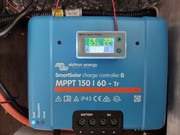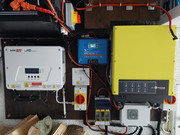So as some of you know I recently completed my build and added my 15 LF280Ks in parallel with my 6 Pylontechs.
The initial evening of discharging looked promising, the voltages held up longer than they used to so the extra capacity is clearly being used, no problem there. I also monitored the first couple of hours of charging and indeed, it charged a lot slower, to be expected as there's a lot more capacity
I left it to it and went to bed. In the morning I noticed that the Pylontechs hadn't reported 100% SOC at any point overnight. They'd peaked at 88% and actually the voltages "wobbled" a bit. Here's some Grafana charts of what the Luxpower was reporting.
So first is the charge rate. This flatlines at 3.5kW for a few hours to be expected, drops a bit at 1am, then zig-zags around a bit:

Here's the battery voltage over the same time:

This peaks at 51.5v at 1am, then wobbles between 51.1v and 51.4v for an hour. The drop at the end is the end of Go Faster so charging is turned off and it drops off to 50.1v
Now here's the clue I think. This is a graph of the maximum charge current requested by the Pylontechs:

I've zoomed this in a bit to where the problems start. Its at 150A (the max for 6 packs, I think) until 00:50. It then gradually drops to 135A, then 130A, but then around 1:20am it plummets to 15A - but only for one reporting period, then it shoots back up to 130A - then back down again! It does this a few times.
So really whats happening is the inverter is just doing as its told and reducing charge current when the Pylontech asks it to.
My theory is the new DIY batteries have a slightly different charge curve to the Pylons. I think the Pylons are basically getting to the voltage that they're full, but the DIY stack isn't (and is probably eating most of the charge current by this point, I can't measure that yet). So the Pylons reduce the requested current. However this cuts off charging to the DIY stack as well which isn't full, so its voltage drops, which pulls the Pylons back down (probably even the Pylons end up charging the DIY a bit?), so they request more charge current again. This goes on for a while and I think they never have time to really get in balance so the reported SOC never hits 100%.
So the biggest problem here that I can see, if the Pylons never get to 100% (I've seen this same behaviour for two nights now) then eventually they'll request a full charge from the inverter, which can happen at any time, probably during peak period, and it could take a day or more during which time I'm eating peak electricity and not getting any battery gain.
My first experiment to try and alleviate this is to do as nowty (I think) suggested and just go the "this is a lead acid battery, dear inverter" route and turn off the smarts. I've experimentally done this this morning and its charging now with a high-set voltage of 53.0v. I want to check this works properly before trying it in the middle of the night
I think the way forward for me is possibly to sell the Pylontechs and maybe buy another 15 LF280s. I kind of wanted to do that anyway so this is kind of cementing the decision now. Especially as I've lost the modbus connection and the SOC reading on the inverter (it immediately dropped from 85% to 25% when I told it it was a lead acid battery.. clearly not right).
Joeboy I'd be especially interested to know if you see similar things when you get your stack built!




